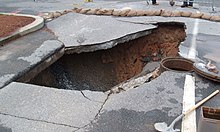Sinkhole
A sinkhole, also known as a sink, shake hole, swallow hole, swallet, doline (in the Slovene language dolina means valley) or cenote, is a natural depression or hole in the surface topography caused by the removal of soil or bedrock, often both, by water. Sinkholes may vary in size from less than a meter to several hundred meters in diameter and depth, and vary in form from soil-lined bowls to bedrock-edged chasms. They may be formed gradually or suddenly, and are found worldwide.
Mechanism of formation may include the gradual removal of slightly soluble bedrock (such as limestone) by percolating water, the collapse of a cave roof, or a lowering of the water table. Occasionally a sinkhole may exhibit a visible opening into a cave below. In the case of exceptionally large sinkholes, such as Cedar Sink at Mammoth Cave National Park, a stream or river may be visible across its bottom flowing from one side to the other.
Sinkholes may capture surface drainage for running or a standing water, but may also form in currently high and dry locations. Florida is known for having frequent sinkholes, especially in the central part of the state. The Murge area in southern Italy also has numerous sinkholes.


Sinkholes are usually but not always linked with karst landscapes. In such regions, there may be hundreds or even thousands of sinkholes in a small area so that the surface as seen from the air looks pock-marked, and there are no surface streams because all drainage occurs sub-surface.
Sinkholes have been used for centuries as disposal sites for various forms of waste. A consequence of this is the pollution of groundwater resources, with serious health implications in such areas.
Sinkholes also form from human activity, such as the rare but still occasional collapse of abandoned mines in places like West Virginia. More commonly, sinkholes occur in urban areas due to water main breaks or sewer collapses when old pipes give way. They can also occur from the overpumping and extraction of groundwater and subsurface fluids.
When sinkholes are very deep or connected to caves, they may offer challenges for experienced cavers or, when water-filled, divers. Some of the most spectacular are the Zacatón cenote in Mexico, the Boesmansgat sinkhole in South Africa, Sarisariñama tepuy in Venezuela, and in the town of Mount Gambier, South Australia.
See also
